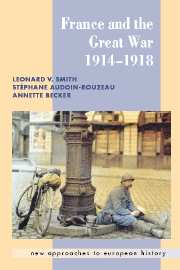36 results
Do children with congenital heart defects meet the vaccination recommendations? Immunisation in children with congenital heart defects
-
- Journal:
- Cardiology in the Young / Volume 32 / Issue 7 / July 2022
- Published online by Cambridge University Press:
- 27 September 2021, pp. 1143-1148
-
- Article
- Export citation
The coastal lowland of northwestern Germany as an archive of Holocene landscape evolution: basis for a spatial evaluation of Stone Age settlement patterns in the Dornumer tidal basin
- Part of
-
- Journal:
- Netherlands Journal of Geosciences / Volume 100 / 2021
- Published online by Cambridge University Press:
- 25 February 2021, e5
-
- Article
-
- You have access
- Open access
- HTML
- Export citation
Georg Simmel Face à la guerre. Écrits 1914-1916 éd. et trad. par J.-L. Evard, Paris, Éd. Rue d’Ulm, 2015, 119 p.
-
- Journal:
- Annales. Histoire, Sciences Sociales / Volume 74 / Issue 3-4 / September 2019
- Published online by Cambridge University Press:
- 12 October 2020, pp. 890-892
- Print publication:
- September 2019
-
- Article
- Export citation
From the Bulletin International des Sociétés de la Croix Rouge to the International Review of the Red Cross: The Great War as a revelator
-
- Journal:
- International Review of the Red Cross / Volume 100 / Issue 907-909 / April 2018
- Published online by Cambridge University Press:
- 03 July 2019, pp. 97-113
-
- Article
- Export citation
Dark tourism: The “heritagization” of sites of suffering, with an emphasis on memorials of the genocide perpetrated against the Tutsi of Rwanda
-
- Journal:
- International Review of the Red Cross / Volume 101 / Issue 910 / April 2019
- Published online by Cambridge University Press:
- 17 April 2019, pp. 317-331
-
- Article
- Export citation
The Great War: World war, total war
-
- Journal:
- International Review of the Red Cross / Volume 97 / Issue 900 / December 2015
- Published online by Cambridge University Press:
- 18 August 2016, pp. 1029-1045
-
- Article
-
- You have access
- HTML
- Export citation
25 - Visual essay: civil society
- from Part VI - A Reckoning: Costs and Outcomes
-
-
- Book:
- The Cambridge History of the First World War
- Published online:
- 05 December 2013
- Print publication:
- 09 January 2014, pp 640-643
-
- Chapter
- Export citation
Contributors
-
-
- Book:
- The Cambridge History of the First World War
- Published online:
- 05 December 2013
- Print publication:
- 09 January 2014, pp xv-xvi
-
- Chapter
- Export citation
20 - Arts
- from Part V - The Social History of Cultural Life
-
-
- Book:
- The Cambridge History of the First World War
- Published online:
- 05 December 2013
- Print publication:
- 09 January 2014, pp 504-527
-
- Chapter
- Export citation
Contributors
-
-
- Book:
- The Cambridge History of the First World War
- Published online:
- 05 December 2013
- Print publication:
- 09 January 2014, pp xiv-xv
-
- Chapter
- Export citation
11 - Captive civilians
- from Part III - Populations at Risk
-
-
- Book:
- The Cambridge History of the First World War
- Published online:
- 05 December 2013
- Print publication:
- 09 January 2014, pp 257-282
-
- Chapter
- Export citation
Contributors
-
-
- Book:
- The Ancient World in Silent Cinema
- Published online:
- 05 September 2013
- Print publication:
- 15 August 2013, pp xv-xix
-
- Chapter
- Export citation
Micropatterning of Fe-based bulk metallic glass surfaces by pulsed electrochemical micromachining
-
- Journal:
- Journal of Materials Research / Volume 27 / Issue 23 / 14 December 2012
- Published online by Cambridge University Press:
- 31 October 2012, pp. 3033-3040
- Print publication:
- 14 December 2012
-
- Article
- Export citation
The dilemmas of protecting civilians in occupied territory: the precursory example of World War I
-
- Journal:
- International Review of the Red Cross / Volume 94 / Issue 885 / March 2012
- Published online by Cambridge University Press:
- 17 October 2012, pp. 117-132
-
- Article
- Export citation
Cédric Weis Jeanne Alexandre, une pacifiste intégrale Angers, Presses de l’université d’Angers, 2005, 293 p.
-
- Journal:
- Annales. Histoire, Sciences Sociales / Volume 63 / Issue 5 / October 2008
- Published online by Cambridge University Press:
- 04 May 2017, pp. 1189-1190
- Print publication:
- October 2008
-
- Article
- Export citation
Serge Jaumain et al. (dir.) Une guerre totale ? La Belgique dans la Première Guerre mondiale Bruxelles, Archives générales du Royaume, 2005, 663 p.
-
- Journal:
- Annales. Histoire, Sciences Sociales / Volume 63 / Issue 5 / October 2008
- Published online by Cambridge University Press:
- 04 May 2017, pp. 1186-1187
- Print publication:
- October 2008
-
- Article
- Export citation
1 - The national community goes to war
-
- Book:
- France and the Great War
- Published online:
- 05 June 2012
- Print publication:
- 13 March 2003, pp 9-41
-
- Chapter
- Export citation

France and the Great War
-
- Published online:
- 05 June 2012
- Print publication:
- 13 March 2003
Plates
-
- Book:
- France and the Great War
- Published online:
- 05 June 2012
- Print publication:
- 13 March 2003, pp xii-xii
-
- Chapter
- Export citation
Conclusion
-
- Book:
- France and the Great War
- Published online:
- 05 June 2012
- Print publication:
- 13 March 2003, pp 182-190
-
- Chapter
- Export citation



